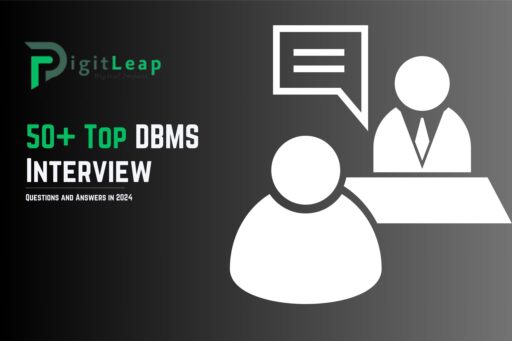50+ Top DBMS Interview Questions and Answers in 2024
The Database Management System (DBMS) is a critical area for anyone aiming to build a career in data management, software development, or IT. Whether you’re applying for a developer role or a database administrator position, being familiar with common DBMS interview questions can be a game-changer. Below, you’ll find the top DBMS interview questions and answers that will help you prepare for your interview in 2024.
1. What is DBMS?
Answer:
DBMS stands for Database Management System. It is software used to store, manage, and retrieve data efficiently. It helps users and applications interact with databases by abstracting the complexities of data management.
2. What are the types of DBMS?
Answer:
DBMS can be categorized into four types:
- Hierarchical DBMS
- Network DBMS
- Relational DBMS (RDBMS)
- Object-oriented DBMS (OODBMS)
3. What is a Relational Database Management System (RDBMS)?
Answer:
RDBMS is a type of DBMS based on the relational model, where data is stored in tables, and relationships between data are also stored in tabular form. It uses Structured Query Language (SQL) for managing and querying the database.
4. Explain ACID properties in DBMS.
Answer:
ACID properties ensure reliable processing of database transactions:
- Atomicity: Transactions are all-or-nothing.
- Consistency: Data must remain consistent before and after the transaction.
- Isolation: Transactions must remain isolated until they are completed.
- Durability: Once a transaction is committed, it remains so even in the case of a system failure.
5. What is normalization in DBMS?
Answer:
Normalization is the process of organizing the data in a database to reduce redundancy and improve data integrity. It involves dividing large tables into smaller, related tables and is typically divided into normal forms (1NF, 2NF, 3NF, etc.).
6. Explain the different types of normalization.
Answer:
- First Normal Form (1NF): Ensures that each column contains atomic values.
- Second Normal Form (2NF): Requires 1NF and removes partial dependencies.
- Third Normal Form (3NF): Requires 2NF and eliminates transitive dependencies.
7. What is denormalization?
Answer:
Denormalization is the process of combining normalized tables into larger tables to optimize database performance. It is used to reduce the time required for database read operations.
8. What is a primary key?
Answer:
A primary key is a unique identifier for each record in a table. It ensures that no duplicate values exist and that the key cannot be null.
9. What is a foreign key?
Answer:
A foreign key is a field in a table that is used to establish a link between two tables. It refers to the primary key in another table, creating a relationship between the tables.
10. What is SQL?
Answer:
SQL stands for Structured Query Language. It is the standard language used for querying and manipulating data in relational databases.
11. Explain the difference between SQL and NoSQL.
Answer:
- SQL: Uses a structured format with tables and is ideal for handling structured data with relationships. It follows ACID properties.
- NoSQL: Works well with unstructured data and does not rely on a fixed schema. NoSQL databases offer scalability and flexibility but may not always follow ACID properties.
12. What is a view in SQL?
Answer:
A view is a virtual table based on the result of a query. It does not store data itself but displays data stored in other tables.
13. What is an index in DBMS?
Answer:
An index is a database structure that improves the speed of data retrieval. It acts like a pointer to quickly locate the data without searching the entire table.
14. What are the different types of indexes?
Answer:
- Clustered Index: Reorders the actual data on the disk to match the index.
- Non-Clustered Index: Creates a separate structure to store the index, leaving the data in the original order.
15. What is a transaction in DBMS?
Answer:
A transaction is a sequence of one or more SQL operations performed as a single unit. It must follow ACID properties to ensure data consistency and reliability.
16. What is the difference between DELETE and TRUNCATE commands?
Answer:
- DELETE: Removes rows one by one and can have a WHERE clause.
- TRUNCATE: Removes all rows from a table without logging individual row deletions and cannot be rolled back.
17. What is a stored procedure?
Answer:
A stored procedure is a precompiled collection of one or more SQL statements that can be executed as a single unit. It helps improve performance and security.
18. What are triggers in DBMS?
Answer:
Triggers are SQL code that automatically executes in response to certain events on a table, such as INSERT, UPDATE, or DELETE operations.
19. What is a join in SQL?
Answer:
A join is an SQL operation that combines records from two or more tables based on a related column between them.
20. Explain different types of joins.
Answer:
- INNER JOIN: Returns records with matching values in both tables.
- LEFT JOIN (LEFT OUTER JOIN): Returns all records from the left table and matched records from the right table.
- RIGHT JOIN (RIGHT OUTER JOIN): Returns all records from the right table and matched records from the left table.
- FULL JOIN (FULL OUTER JOIN): Returns all records when there is a match in either table.
21. What is referential integrity?
Answer:
Referential integrity ensures that relationships between tables remain consistent. For example, it prevents the deletion of a record that is referenced by a foreign key in another table.
22. What is a schema in DBMS?
Answer:
A schema is the structural definition of the database, including tables, views, indexes, relationships, and permissions.
23. What is a cursor in SQL?
Answer:
A cursor is a database object used to retrieve, manipulate, and navigate through a result set row by row.
24. What are the advantages of DBMS?
Answer:
- Data redundancy is minimized.
- Data consistency is improved.
- Data security is enhanced.
- Data sharing is facilitated among multiple users.
- Backup and recovery are simplified.
25. What is the difference between DBMS and RDBMS?
Answer:
- DBMS: Stores data in files without relationships between them.
- RDBMS: Stores data in tables with relationships and enforces integrity constraints.
26. What is a deadlock in DBMS?
Answer:
A deadlock occurs when two or more transactions block each other, waiting for resources that the other holds, causing an indefinite wait.
27. Explain the difference between HAVING and WHERE clauses.
Answer:
- WHERE: Filters rows before groupings are made.
- HAVING: Filters groups after the GROUP BY clause has been applied.
28. What is data redundancy?
Answer:
Data redundancy refers to the unnecessary duplication of data within a database, which can lead to inconsistencies.
29. What is concurrency control?
Answer:
Concurrency control ensures that database transactions are executed concurrently without leading to data inconsistency.
30. What is a data warehouse?
Answer:
A data warehouse is a centralized repository for storing large volumes of structured data from different sources for reporting and analysis.
31. What is a data model in DBMS?
Answer:
A data model defines the logical structure of a database, including tables, relationships, and constraints. Common types of data models include the Hierarchical model, Network model, Relational model, and Object-oriented model.
32. What are the advantages of a relational data model?
Answer:
- Simplicity: Data is organized in simple tables (relations).
- Data Independence: Data storage details are separated from the application logic.
- Scalability: Easily handles large amounts of data.
- Flexibility: Tables can easily be updated, expanded, or queried.
33. What is a candidate key?
Answer:
A candidate key is a set of one or more columns in a table that can uniquely identify any row in the table. One of these candidate keys is chosen as the primary key.
34. What is a composite key?
Answer:
A composite key is a key that consists of two or more columns to uniquely identify a record in a table.
35. What is a surrogate key?
Answer:
A surrogate key is an artificial key assigned to a record when no natural primary key exists. It is typically an auto-incremented number or a unique identifier.
36. Explain the difference between a clustered and non-clustered index.
Answer:
- Clustered Index: Sorts and stores the data rows in the table based on the key values. Only one clustered index can exist per table.
- Non-Clustered Index: Maintains a separate structure to store the index, and the data rows are not sorted. You can have multiple non-clustered indexes per table.
37. What is an ER diagram?
Answer:
An Entity-Relationship (ER) diagram is a graphical representation of entities and their relationships to each other in a database. It is used to visualize database structure and design.
38. What are functional dependencies in DBMS?
Answer:
A functional dependency occurs when one attribute in a relation uniquely determines another attribute. For example, if A → B, the value of B is functionally dependent on A.
39. What is a self-join?
Answer:
A self-join is a regular join where a table is joined with itself to compare rows within the same table. This is typically used to compare rows based on related columns.
40. Explain the difference between UNION and UNION ALL.
Answer:
- UNION: Combines the result sets of two SELECT queries and removes duplicate rows.
- UNION ALL: Combines the result sets of two SELECT queries without removing duplicates.
41. What is a materialized view?
Answer:
A materialized view is a database object that contains the results of a query and is stored physically. Unlike regular views, materialized views are updated periodically and allow faster access to complex query results.
42. What are constraints in DBMS?
Answer:
Constraints are rules enforced on data columns in a table to ensure the integrity and accuracy of the data. Types of constraints include:
- NOT NULL
- UNIQUE
- PRIMARY KEY
- FOREIGN KEY
- CHECK
43. What is the difference between DROP, DELETE, and TRUNCATE?
Answer:
- DELETE: Removes specific rows from a table based on a condition and can be rolled back.
- TRUNCATE: Removes all rows from a table but does not log individual row deletions. Cannot be rolled back.
- DROP: Deletes the entire table (schema and data).
44. What is a transaction log?
Answer:
A transaction log records all transactions and database modifications made during a transaction. It is crucial for database recovery and rollback operations in case of system failure.
45. What is a database schema?
Answer:
A database schema defines the structure of a database, including the tables, columns, data types, relationships, and constraints.
46. What is data independence?
Answer:
Data independence refers to the ability to change the database schema at one level without affecting the schema at the next higher level. It is divided into:
- Logical data independence: Ability to change the conceptual schema without affecting the application.
- Physical data independence: Ability to change the internal schema without affecting the conceptual schema.
47. Explain two-phase commit in DBMS.
Answer:
The two-phase commit protocol ensures that a distributed transaction is either committed or rolled back across all participating databases. It consists of two phases:
- Prepare Phase: Each participant confirms they are ready to commit.
- Commit Phase: If all participants are ready, the transaction is committed; otherwise, it is rolled back.
48. What are the different types of relationships in DBMS?
Answer:
- One-to-One (1:1): One record in a table is related to one record in another table.
- One-to-Many (1): One record in a table can relate to multiple records in another table.
- Many-to-Many (M): Multiple records in a table can relate to multiple records in another table.
49. What is data abstraction in DBMS?
Answer:
Data abstraction is the process of hiding the complexities of database structures and providing users with a simplified view. There are three levels of abstraction:
- Physical Level: How the data is stored.
- Logical Level: What data is stored and the relationships among the data.
- View Level: How users interact with the data.
50. What is a B-Tree in DBMS?
Answer:
A B-Tree is a self-balancing tree data structure that maintains sorted data and allows for efficient insertion, deletion, and search operations. It is commonly used in database indexing.
51. What is a hash index in DBMS?
Answer:
A hash index is created based on a hash function that maps keys to specific locations in memory. Hash indexing is efficient for equality searches but not suitable for range queries.
52. What are phantom reads in DBMS?
Answer:
Phantom reads occur when a transaction reads a set of rows that match a condition, but upon a subsequent read, new rows that match the condition have been added by another transaction.
53. Explain RAID in DBMS.
Answer:
RAID (Redundant Array of Independent Disks) is a technology used to improve database storage reliability and performance by combining multiple physical disk drives into a single logical unit. Common RAID levels include RAID 0 (striping), RAID 1 (mirroring), and RAID 5 (striping with parity).
54. What is a correlated subquery?
Answer:
A correlated subquery is a subquery that refers to a column from the outer query. It is executed once for every row selected by the outer query.
55. What is a tuple in DBMS?
Answer:
A tuple is a single row or record in a table. It represents an instance of data in a relation, containing values for all the columns in that row.
56. Explain locking mechanisms in DBMS.
Answer:
Locking mechanisms ensure that concurrent transactions do not lead to data inconsistencies. There are two main types of locks:
- Shared Lock: Multiple transactions can read the data but not modify it.
- Exclusive Lock: Only one transaction can read or modify the data at a time.
57. What is the difference between OLTP and OLAP?
Answer:
- OLTP (Online Transaction Processing): Designed for day-to-day transactional processing. It focuses on quick insert, update, and delete operations.
- OLAP (Online Analytical Processing): Designed for analytical queries and data reporting. It focuses on read-heavy operations, typically involving large volumes of historical data.
Other Important Q&A List :
- OOPs Interview Questions And Answers
- SQL Interview Questions and Answers
- Content Writing Interview Questions and Answers
- Email Marketing Interview Questions and Answers
- Django Interview Questions and Answers
- C Programming Interview Questions and Answers
- ReactJS Interview Questions and Answers
- Angular Interview Questions and Answers
- Power BI Interview Questions and Answers
- Top DBMS Interview Questions and Answers
- Python Interview Questions and Answers
- MySQL Interview Questions and Answers
- Java Interview Questions and Answers
- Data Structures Interview Questions
- Flutter Interview Questions and Answers
- JavaScript Interview Questions and Answers
- PHP Interview Questions and Answers
- CSS Interview Questions and Answers
- HTML Interview Questions and Answers






